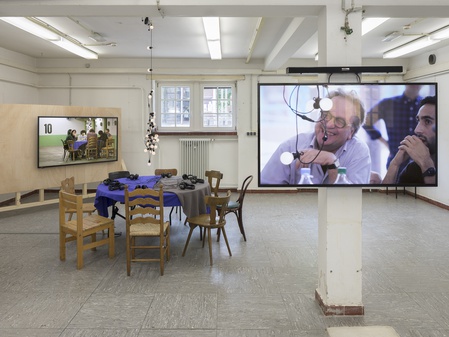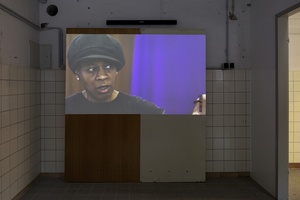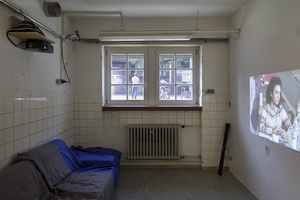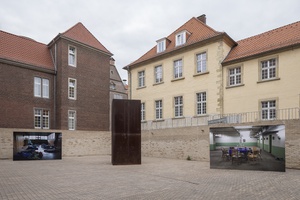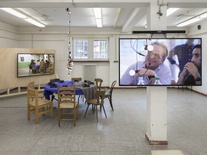Koki Tanaka
Provisional Studies: Workshop #7 How to Live Together and Sharing the Unknown
2017, Skulptur Projekte 2017
Action and workshops, installation of the video documentation in four rooms, booklet
Location
Johannisstraße 18/20, access via the passage between Johannisstraße 18/20 and 21, opposite Aegidiimarkt
Accompanying booklet available on-site
Temporary Installation for the duration of the exhibition
Owner
After Skulptur Projekte 2017 the work was purchased for the collection of LWL Museum für Kunst und Kultur, Münster and will be shown in temporary exhibitions.
Participants’ workshops
Tasnim Baghdadi, Stephan Biermann, Isa Selçuk Dilmen, Annette Hinricher, Anna Mondain-Monval, JoAnn Osborne, Rolf Tiemann, Lina Zaher
Facilitators’ workshops
Ahmad Alajlan, Kai van Eikels, Andrew Maerkle, Hendrik Meyer, Tami Tanagisawa
Crew
Director of photography: Hikaru Fujii
Sound: Ryota Fujiguchi
Editor: Koki Tanaka
Camera operator: Shinya Aoyama
Boom operator: Kadoaki Izuta
Assistants: Lejla Aliev, Jakob Reuter
Workshop / filming coordination: Sophia Trollmann
Assistant: Alexandra Südkamp
Logistics: Jan Enste / jae kunst und medien
Textiles support: Kvadrat
Equipment rental and support: Kunstakademie Münster, Filmwerkstatt Münster e. V., Atelier Screen TV, ARTISTS’ GUILD, C-RENT, CAMCAR, cineOne
Subtitles: Eurotape – Media Services GmbH
Koki Tanaka
* 1975 Tochigi, Japan, lives in Kyoto, Japan
Since the events of Fukushima, if not before, Koki Tanaka’s art has been centred around crises and the temporary communities that they produce. Tanaka brings people together in unaccustomed situations that are often unsettling. In these unusual collective moments, he tests the possibility of defying existing routines. The documentary footage that was produced in these situations and workshops serves in various forms as the basis for his video installations.
For Skulptur Projekte, Tanaka asked eight residents of Münster from various generations and different cultural backgrounds to participate in workshops for nine days. Based on Roland Barthes’s book of the same title, the central question was, how to live together? Tanaka invited contributions from ‘facilitators’ acting as temporary guests and sources of inspiration.
A total of eleven video sequences document things such as the night spent together on mats in the gymnasium, cooking a wartime recipe, the interview and shoot with a globalization expert from Syria, and physical exercises in an old nuclear bunker. The camera crew was also told to capture all the breaks and interruptions. So we witness moments of exhaustion as well as the moments when stereotypical roles and argument patterns are initiated or set off. And we also see moments of irritation or displeasure. From the very beginning, the presence of a film crew transformed the participants into subjects in front of the camera and, as such, into a designated, temporary, and defined group of performers. During the shoot, Tanaka saw himself as the viewer and leaves it up to the participants to guide the process, including the decision to stop an exercise. Like the everyday objects in the workshop, the artist’s notes were an important part of the work and are designed as independent publications.
The contextual starting point of the project was also the location where it took place: the Aegidiimarkt complex across from the LWL-Museum für Kunst und Kultur. Built in the late 1970s, the building incorporates space for living, shopping, work, and leisure. Next to the adult education centre there is a car park for the section of the building frequented most. It was erected during the Cold War and until 2015 designated as a WMD shelter which could house three thousand people in the event of an emergency. Researching the history of the place, we discover how various communities gathered or lived together there: prior to 1819, there was a monastery on the same site that had been used as a military barracks since 1830. After being destroyed in World War II, the property remained vacant for quite some time. The lines of sight that visitors were offered from the standpoint of the installation were directly connected to the Aegidiimarkt across from it.
Sophia Trollmann
Images
Location
- Still existing / Public Collection
- Removed
- In the museum
